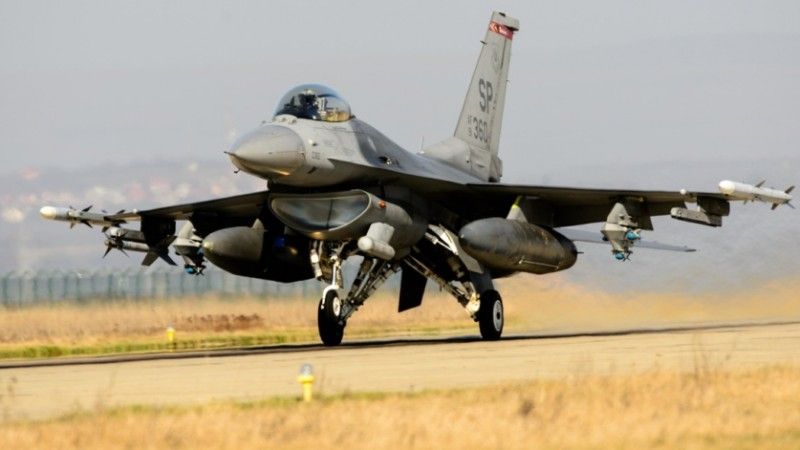Strona główna
Will a 'Wild Weasel' Squadron be Transferred from Germany to Poland? [COMMENTARY]

Polish “Dziennik Gazeta Prawna” claims that US F-16 jets could be transferred from Germany to Poland, as a part of a memorandum signed by and between President Donald Trump and President Andrzej Duda. If the rumors turn out to be true, a squadron of SEAD-specialized F-16s could potentially be deployed to Poland.
“DGP” daily claims that steps aimed at reinforcing the US military presence in Poland would be announced during the Andrzej Duda’s visit to the US. This would happen through a transfer of some of the elements stationed in Germany at the moment. The above refers, among other assets, to a squadron of F-16 jets and the V Army Corps command formed recently.
At the moment a single US F-16 squadron is stationed in Germany. We are mentioning the Spangdahlem AFB 480th Fighter Squadron here, with around 20 jets at its disposal (“DGP” daily mentioned 30 airframes). Transfer of that unit is plausible as it had been listed (by The New York Times for instance) as one to be withdrawn from Germany, in line with the plans made by the Trump administration.
The squadron operates F-16 Block 50 jets that assume the Wild Weasel role. They are tasked with the SEAD mission (Suppression of Enemy Air Defenses). The jets are capable of carrying the HARM/HCSM anti-radiation missiles, while the pilots receive training in SEAD tactics, involving detection of the enemy air defence assets, acting against them and evading engagements.
Deployment of a Wild Weasel squadron to Poland could be viewed as a serious reinforcement of the defensive capabilities. At the moment the Polish Air Force has no similar set of capabilities at its disposal, as the acquisition of the AARGM effectors is only mentioned in the plans for the future. The fact that the jets would be deployed closer to the potential threat could boost their capabilities as well. Flying in the Polish airspace the aircraft could gather relevant intel if the adversary switches on his air defence system radars (ones that provide coverage of the Polish territory).
The Spangdahlem’s Wild Weasels used to train in Poland in the past. Nonetheless, permanent presence could bring things up to a new level, due to the frequency of operations. For infrastructure, hosting an F-16 squadron should not be a problem. Łask Airbase has been prepared, at least to some extent, to host extra jets. It is also possible to deploy the F-16s to other locations.
It also needs to be stressed clearly that the Spangdahlem jets are not nuclear-capable, contrary to another two squadrons based in Aviano, Italy (they are not dual-capable aircraft). This fact has been mentioned back in 2014 by fas.org. Should they be deployed to Poland, the US cannot be accused of permanently stationing nuclear-capable aircraft east of the river Oder.
When it comes to the V Corps Command, the unit is stationed in Fort Knox and comprises of around 635 troops. At the same time, it is to hold rotations of around 200 soldiers in Europe. This would be another tactical US Army command in Poland. Back in 2017 Mission Command Element was transferred to Poznan from Germany. It is a forward division-level command element formed in 2015, as a response to the Russian aggression in Ukraine. Meanwhile, the unit became a division level forward command element with capabilities similar to a full US Army divisional command, in line with a memorandum signed between Andrzej Duda and Donald Trump. The capabilities are maintained by two rotational divisions stationed in the US - the 1st Infantry Division at the moment. The troops are regularly involved in exercises on the Eastern Flank, such as Defender Europe 20 for instance.
Should the news on the deployment of V Corps command and the F-16 squadron to Poland be confirmed, this would be a major reinforcement of defensive potential located here. On the other hand, Poland would be facing extra obligations with regards to the protection of the assets stationed within its territory, e.g. within the scope of defending them from air/missile threat. General Ben Hodges, in his recent interview published by us, told us that Poland would be responsible for protecting the equipment storage in Powidz that is to host equipment for an Armoured Brigade. The same principle will probably be adopted with regards to the V Corps command or the to the airbase.
This would, in turn, mean that the air/missile defence domain would become even more important, within the framework of modernization of the Polish military. Not only would the air/missile defence assets be tasked with protecting of own forces and assets, as they would also be employed to protect the allies. One needs to stress the fact that the US Patriot units are snowed-under with tasks in Asia or the Middle East. Hence, it is difficult to expect them to be able to provide quantitatively sufficient potential in Poland, should a crisis unfold. Meanwhile, the US forces have just started to recover their short-range air defence capabilities (counterpart of the Polish Narew system).
This means that reinforcement of the Polish potential shall entail the reinforced US presence, to make use of that presence to the fullest extent possible. Not only does the above concern the air/missile defence domain, as it also pertains to counterintelligence, counter-sabotage, information, cybernetic, or electronic defence issues.
